FIAT 500 ABARTH CABRIO 2017 2.G Workshop Manual
Manufacturer: FIAT, Model Year: 2017, Model line: 500 ABARTH CABRIO, Model: FIAT 500 ABARTH CABRIO 2017 2.GPages: 338, PDF Size: 2.78 MB
Page 51 of 338
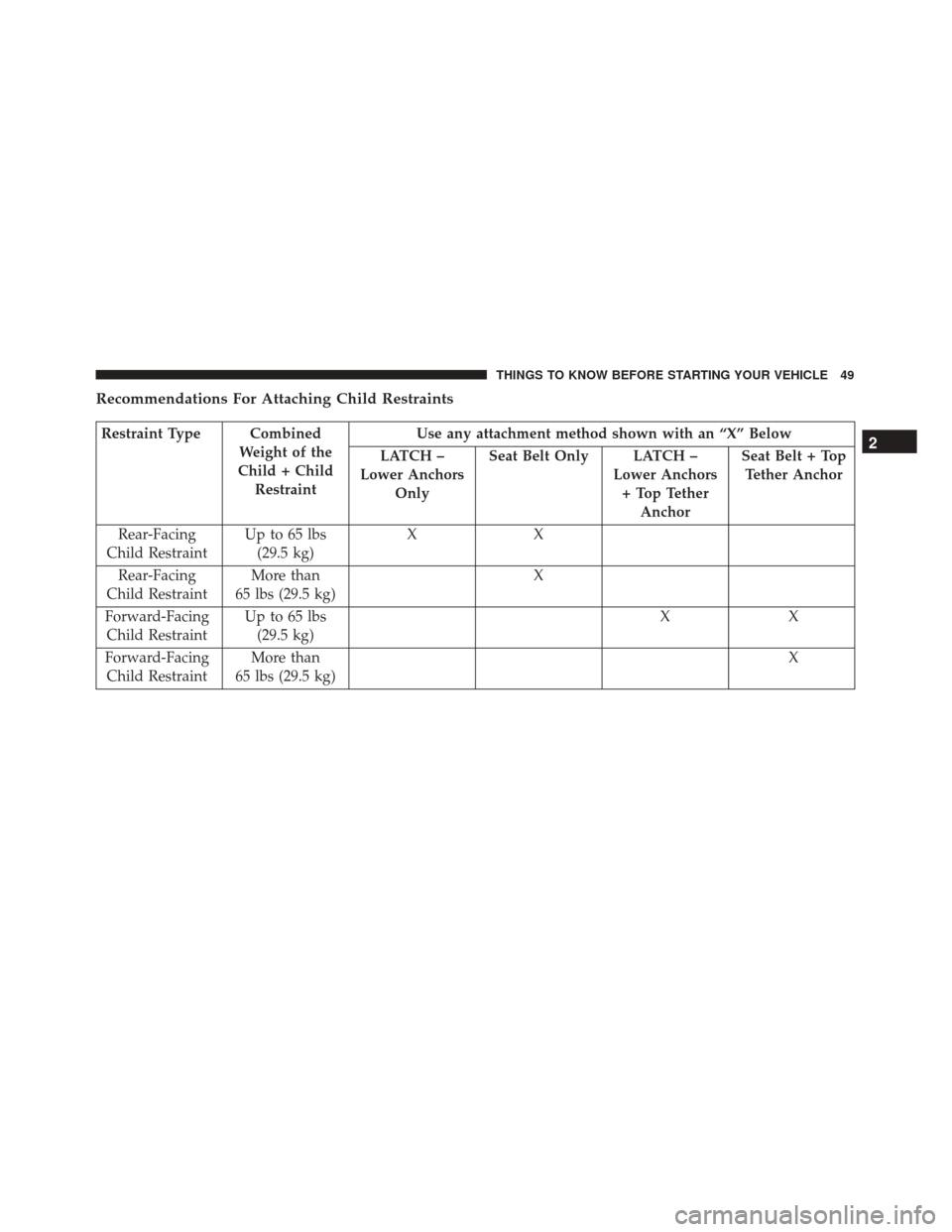
Recommendations For Attaching Child Restraints
Restraint Type CombinedWeight of the
Child + Child Restraint Use any attachment method shown with an “X” Below
LATCH –
Lower Anchors Only Seat Belt Only LATCH –
Lower Anchors+ Top Tether Anchor Seat Belt + Top
Tether Anchor
Rear-Facing
Child Restraint Up to 65 lbs
(29.5 kg) XX
Rear-Facing
Child Restraint More than
65 lbs (29.5 kg) X
Forward-Facing Child Restraint Up to 65 lbs
(29.5 kg) XX
Forward-Facing Child Restraint More than
65 lbs (29.5 kg) X2
THINGS TO KNOW BEFORE STARTING YOUR VEHICLE 49
Page 52 of 338
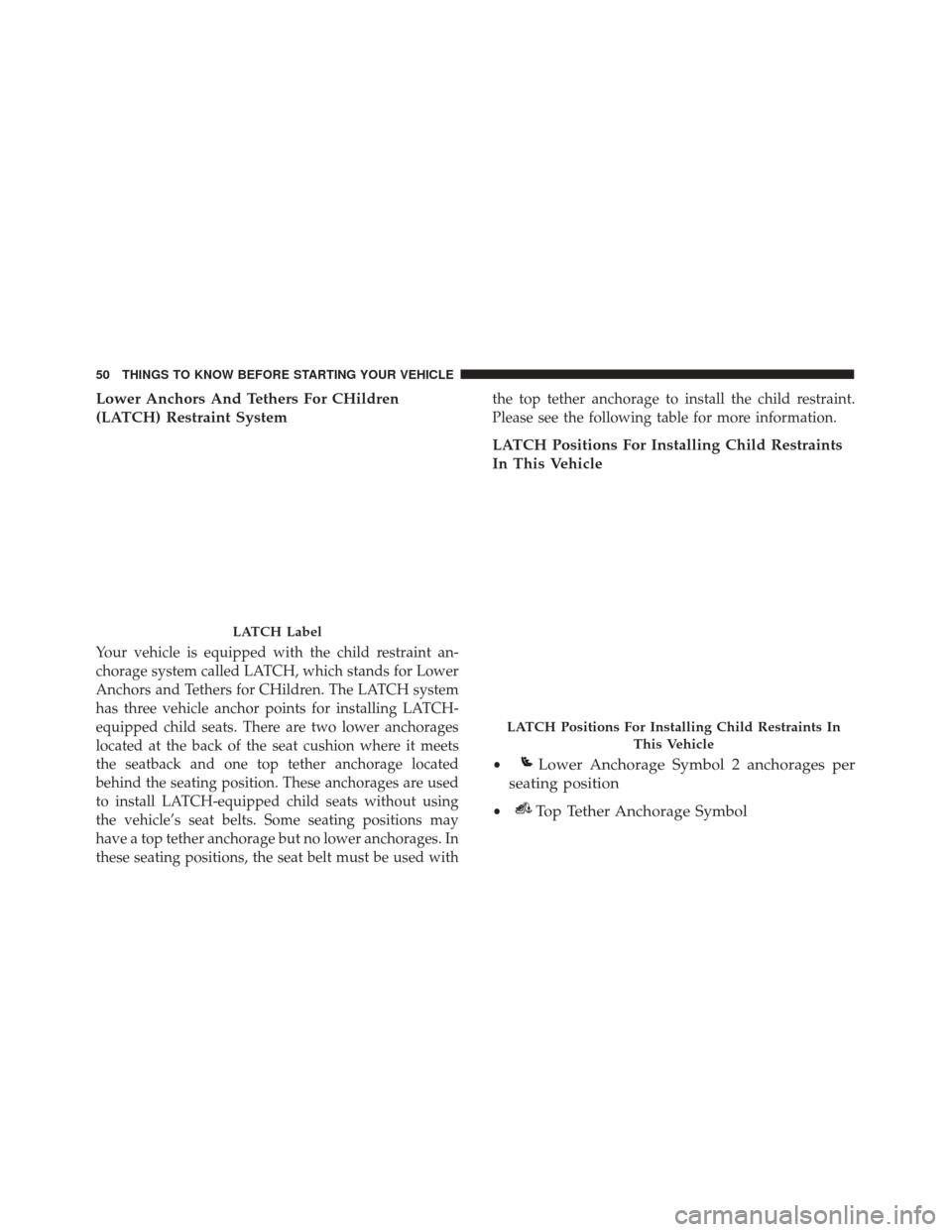
Lower Anchors And Tethers For CHildren
(LATCH) Restraint System
Your vehicle is equipped with the child restraint an-
chorage system called LATCH, which stands for Lower
Anchors and Tethers for CHildren. The LATCH system
has three vehicle anchor points for installing LATCH-
equipped child seats. There are two lower anchorages
located at the back of the seat cushion where it meets
the seatback and one top tether anchorage located
behind the seating position. These anchorages are used
to install LATCH-equipped child seats without using
the vehicle’s seat belts. Some seating positions may
have a top tether anchorage but no lower anchorages. In
these seating positions, the seat belt must be used withthe top tether anchorage to install the child restraint.
Please see the following table for more information.
LATCH Positions For Installing Child Restraints
In This Vehicle
•Lower Anchorage Symbol 2 anchorages per
seating position
•Top Tether Anchorage Symbol
LATCH Label
LATCH Positions For Installing Child Restraints In
This Vehicle
50 THINGS TO KNOW BEFORE STARTING YOUR VEHICLE
Page 53 of 338
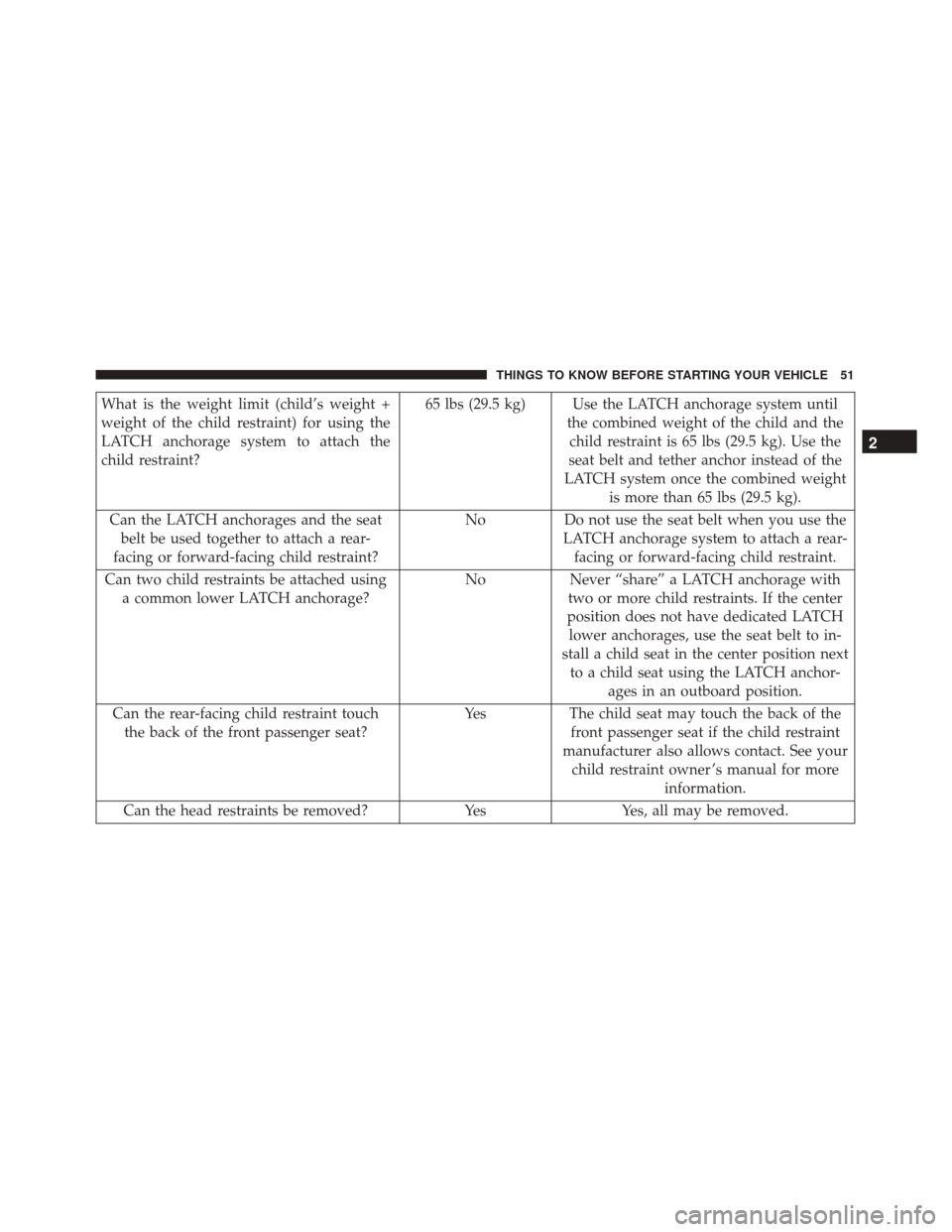
What is the weight limit (child’s weight +
weight of the child restraint) for using the
LATCH anchorage system to attach the
child restraint?65 lbs (29.5 kg) Use the LATCH anchorage system until
the combined weight of the child and thechild restraint is 65 lbs (29.5 kg). Use the
seat belt and tether anchor instead of the
LATCH system once the combined weight is more than 65 lbs (29.5 kg).
Can the LATCH anchorages and the seat belt be used together to attach a rear-
facing or forward-facing child restraint? No Do not use the seat belt when you use the
LATCH anchorage system to attach a rear-facing or forward-facing child restraint.
Can two child restraints be attached using a common lower LATCH anchorage? No
Never “share” a LATCH anchorage with
two or more child restraints. If the center
position does not have dedicated LATCH lower anchorages, use the seat belt to in-
stall a child seat in the center position next to a child seat using the LATCH anchor- ages in an outboard position.
Can the rear-facing child restraint touch the back of the front passenger seat? Yes
The child seat may touch the back of the
front passenger seat if the child restraint
manufacturer also allows contact. See your child restraint owner ’s manual for more information.
Can the head restraints be removed? YesYes, all may be removed.
2
THINGS TO KNOW BEFORE STARTING YOUR VEHICLE 51
Page 54 of 338
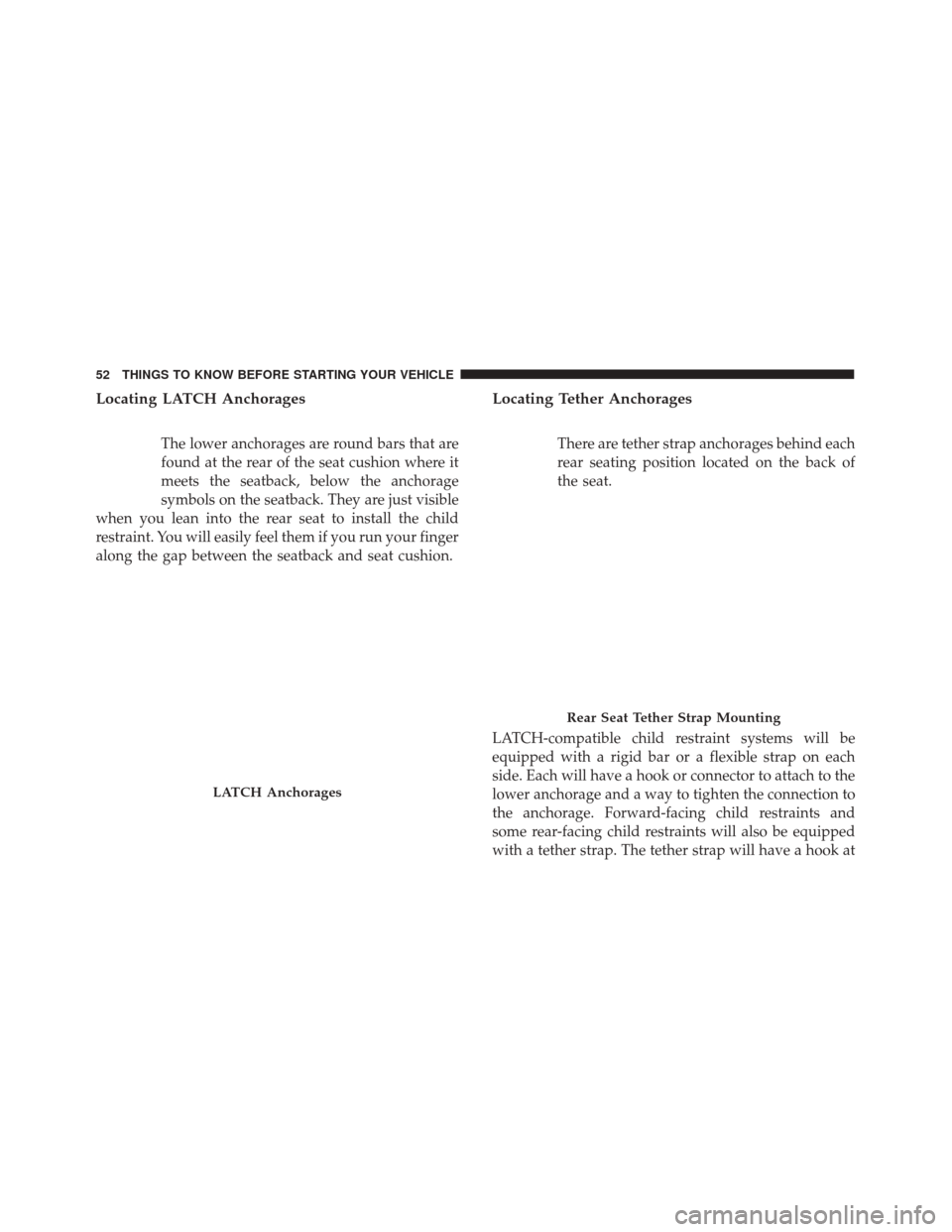
Locating LATCH Anchorages
The lower anchorages are round bars that are
found at the rear of the seat cushion where it
meets the seatback, below the anchorage
symbols on the seatback. They are just visible
when you lean into the rear seat to install the child
restraint. You will easily feel them if you run your finger
along the gap between the seatback and seat cushion.
Locating Tether Anchorages
There are tether strap anchorages behind each
rear seating position located on the back of
the seat.
LATCH-compatible child restraint systems will be
equipped with a rigid bar or a flexible strap on each
side. Each will have a hook or connector to attach to the
lower anchorage and a way to tighten the connection to
the anchorage. Forward-facing child restraints and
some rear-facing child restraints will also be equipped
with a tether strap. The tether strap will have a hook at
LATCH Anchorages
Rear Seat Tether Strap Mounting
52 THINGS TO KNOW BEFORE STARTING YOUR VEHICLE
Page 55 of 338
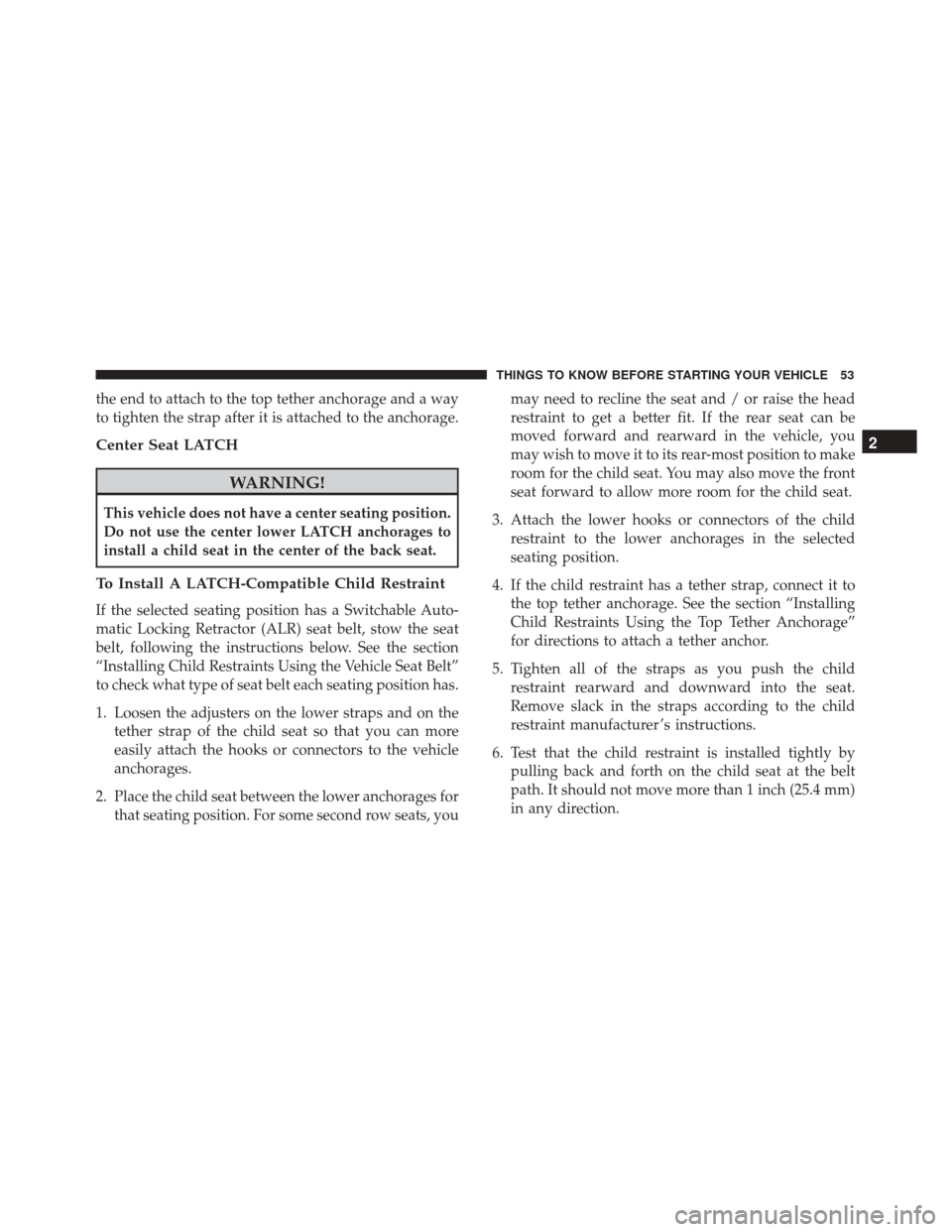
the end to attach to the top tether anchorage and a way
to tighten the strap after it is attached to the anchorage.
Center Seat LATCH
WARNING!
This vehicle does not have a center seating position.
Do not use the center lower LATCH anchorages to
install a child seat in the center of the back seat.
To Install A LATCH-Compatible Child Restraint
If the selected seating position has a Switchable Auto-
matic Locking Retractor (ALR) seat belt, stow the seat
belt, following the instructions below. See the section
“Installing Child Restraints Using the Vehicle Seat Belt”
to check what type of seat belt each seating position has.
1. Loosen the adjusters on the lower straps and on thetether strap of the child seat so that you can more
easily attach the hooks or connectors to the vehicle
anchorages.
2. Place the child seat between the lower anchorages for that seating position. For some second row seats, you may need to recline the seat and / or raise the head
restraint to get a better fit. If the rear seat can be
moved forward and rearward in the vehicle, you
may wish to move it to its rear-most position to make
room for the child seat. You may also move the front
seat forward to allow more room for the child seat.
3. Attach the lower hooks or connectors of the child restraint to the lower anchorages in the selected
seating position.
4. If the child restraint has a tether strap, connect it to the top tether anchorage. See the section “Installing
Child Restraints Using the Top Tether Anchorage”
for directions to attach a tether anchor.
5. Tighten all of the straps as you push the child restraint rearward and downward into the seat.
Remove slack in the straps according to the child
restraint manufacturer ’s instructions.
6. Test that the child restraint is installed tightly by pulling back and forth on the child seat at the belt
path. It should not move more than 1 inch (25.4 mm)
in any direction.
2
THINGS TO KNOW BEFORE STARTING YOUR VEHICLE 53
Page 56 of 338
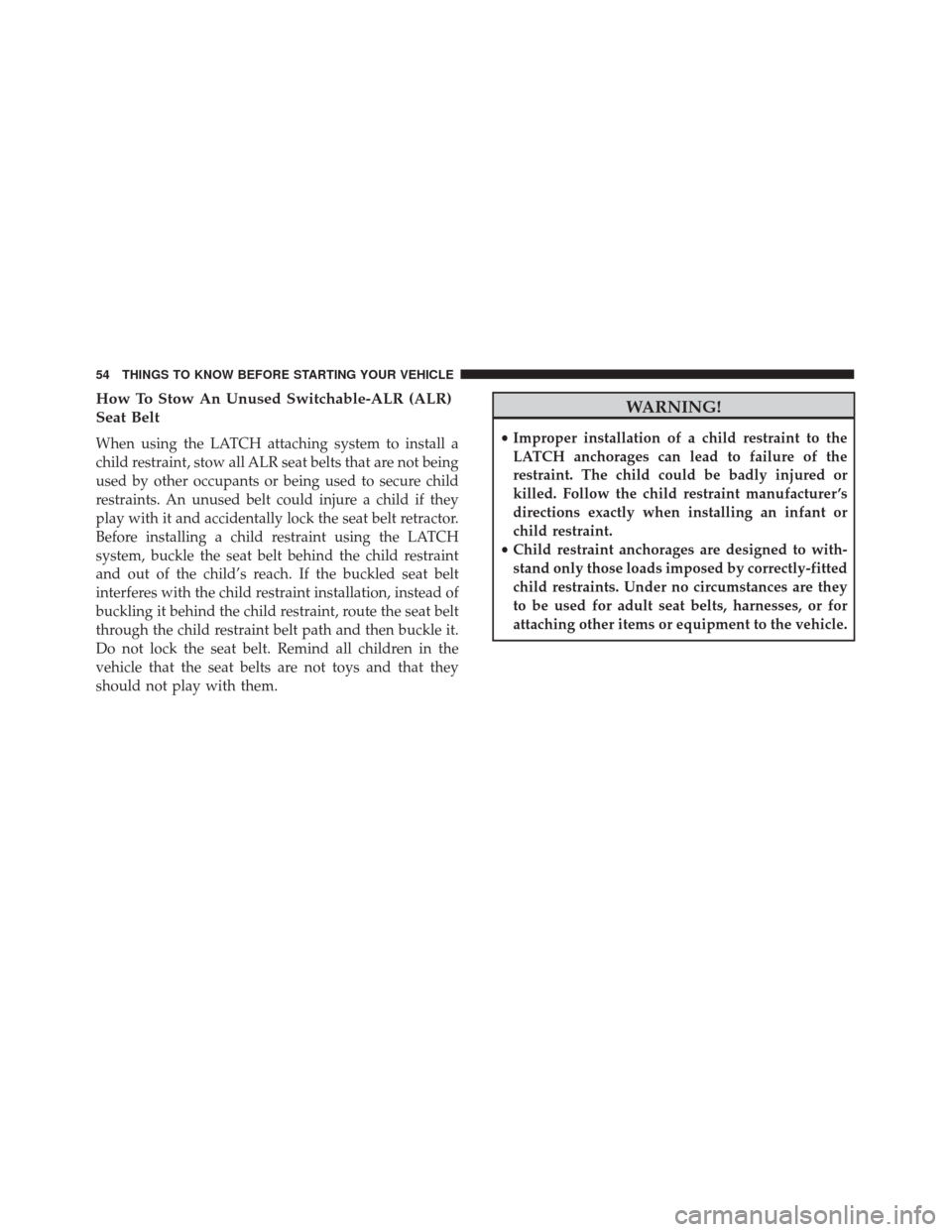
How To Stow An Unused Switchable-ALR (ALR)
Seat Belt
When using the LATCH attaching system to install a
child restraint, stow all ALR seat belts that are not being
used by other occupants or being used to secure child
restraints. An unused belt could injure a child if they
play with it and accidentally lock the seat belt retractor.
Before installing a child restraint using the LATCH
system, buckle the seat belt behind the child restraint
and out of the child’s reach. If the buckled seat belt
interferes with the child restraint installation, instead of
buckling it behind the child restraint, route the seat belt
through the child restraint belt path and then buckle it.
Do not lock the seat belt. Remind all children in the
vehicle that the seat belts are not toys and that they
should not play with them.
WARNING!
•Improper installation of a child restraint to the
LATCH anchorages can lead to failure of the
restraint. The child could be badly injured or
killed. Follow the child restraint manufacturer ’s
directions exactly when installing an infant or
child restraint.
• Child restraint anchorages are designed to with-
stand only those loads imposed by correctly-fitted
child restraints. Under no circumstances are they
to be used for adult seat belts, harnesses, or for
attaching other items or equipment to the vehicle.
54 THINGS TO KNOW BEFORE STARTING YOUR VEHICLE
Page 57 of 338
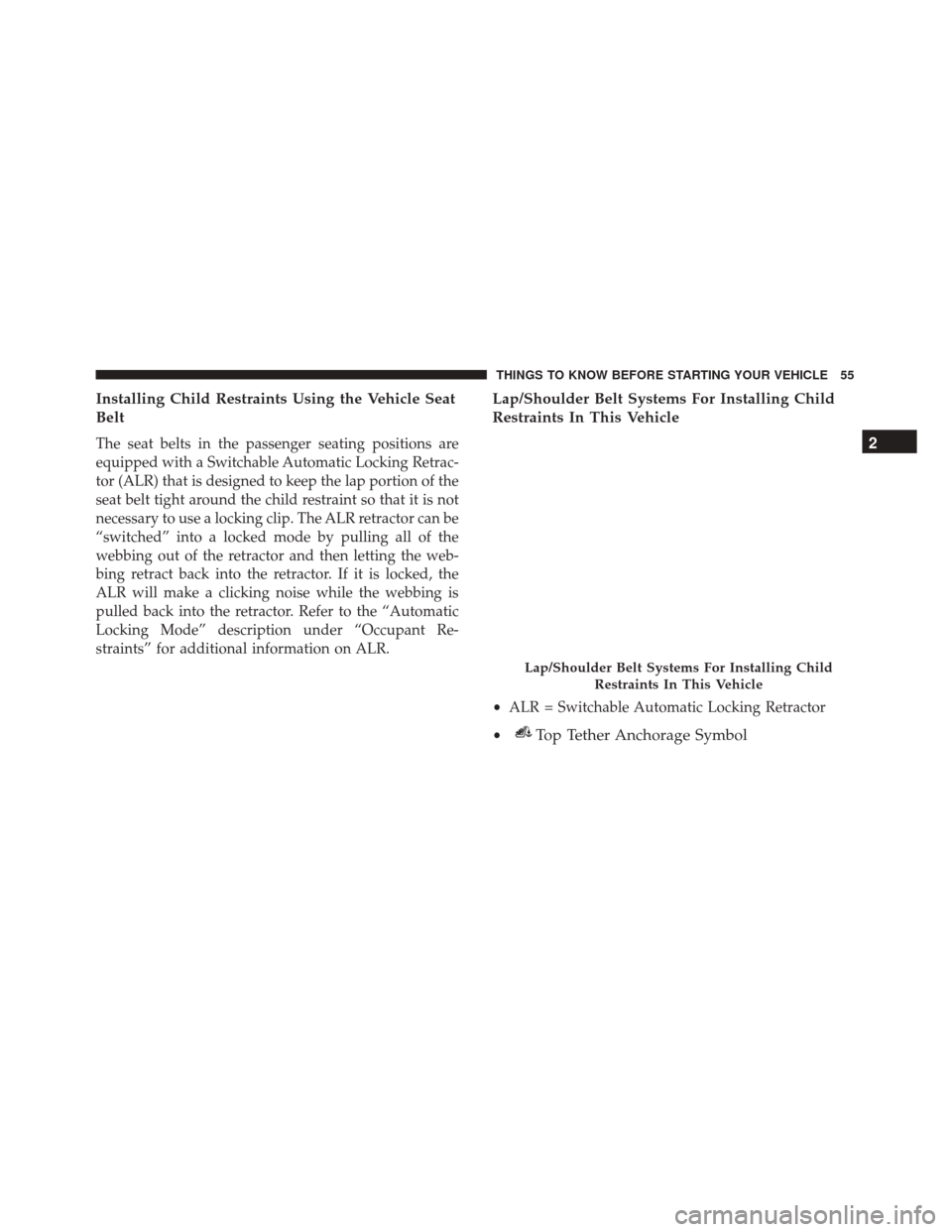
Installing Child Restraints Using the Vehicle Seat
Belt
The seat belts in the passenger seating positions are
equipped with a Switchable Automatic Locking Retrac-
tor (ALR) that is designed to keep the lap portion of the
seat belt tight around the child restraint so that it is not
necessary to use a locking clip. The ALR retractor can be
“switched” into a locked mode by pulling all of the
webbing out of the retractor and then letting the web-
bing retract back into the retractor. If it is locked, the
ALR will make a clicking noise while the webbing is
pulled back into the retractor. Refer to the “Automatic
Locking Mode” description under “Occupant Re-
straints” for additional information on ALR.
Lap/Shoulder Belt Systems For Installing Child
Restraints In This Vehicle
Lap/Shoulder Belt Systems For Installing ChildRestraints In This Vehicle
•ALR = Switchable Automatic Locking Retractor
•
Top Tether Anchorage Symbol 2
THINGS TO KNOW BEFORE STARTING YOUR VEHICLE 55
Page 58 of 338
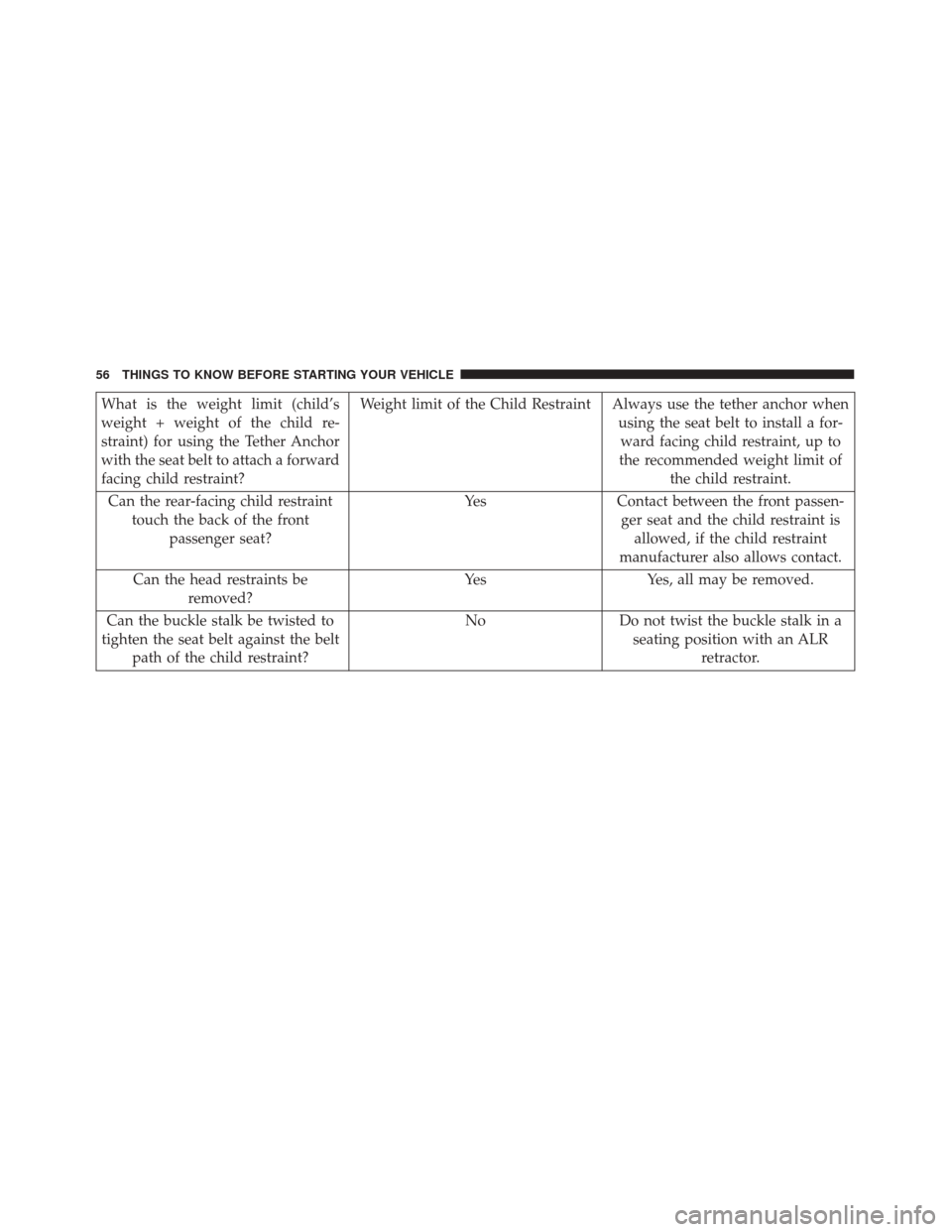
What is the weight limit (child’s
weight + weight of the child re-
straint) for using the Tether Anchor
with the seat belt to attach a forward
facing child restraint?Weight limit of the Child Restraint Always use the tether anchor when
using the seat belt to install a for-ward facing child restraint, up to
the recommended weight limit of the child restraint.
Can the rear-facing child restraint touch the back of the front passenger seat? Yes
Contact between the front passen-
ger seat and the child restraint is allowed, if the child restraint
manufacturer also allows contact.
Can the head restraints be removed? Yes
Yes, all may be removed.
Can the buckle stalk be twisted to
tighten the seat belt against the belt path of the child restraint? No
Do not twist the buckle stalk in a
seating position with an ALR retractor.
56 THINGS TO KNOW BEFORE STARTING YOUR VEHICLE
Page 59 of 338
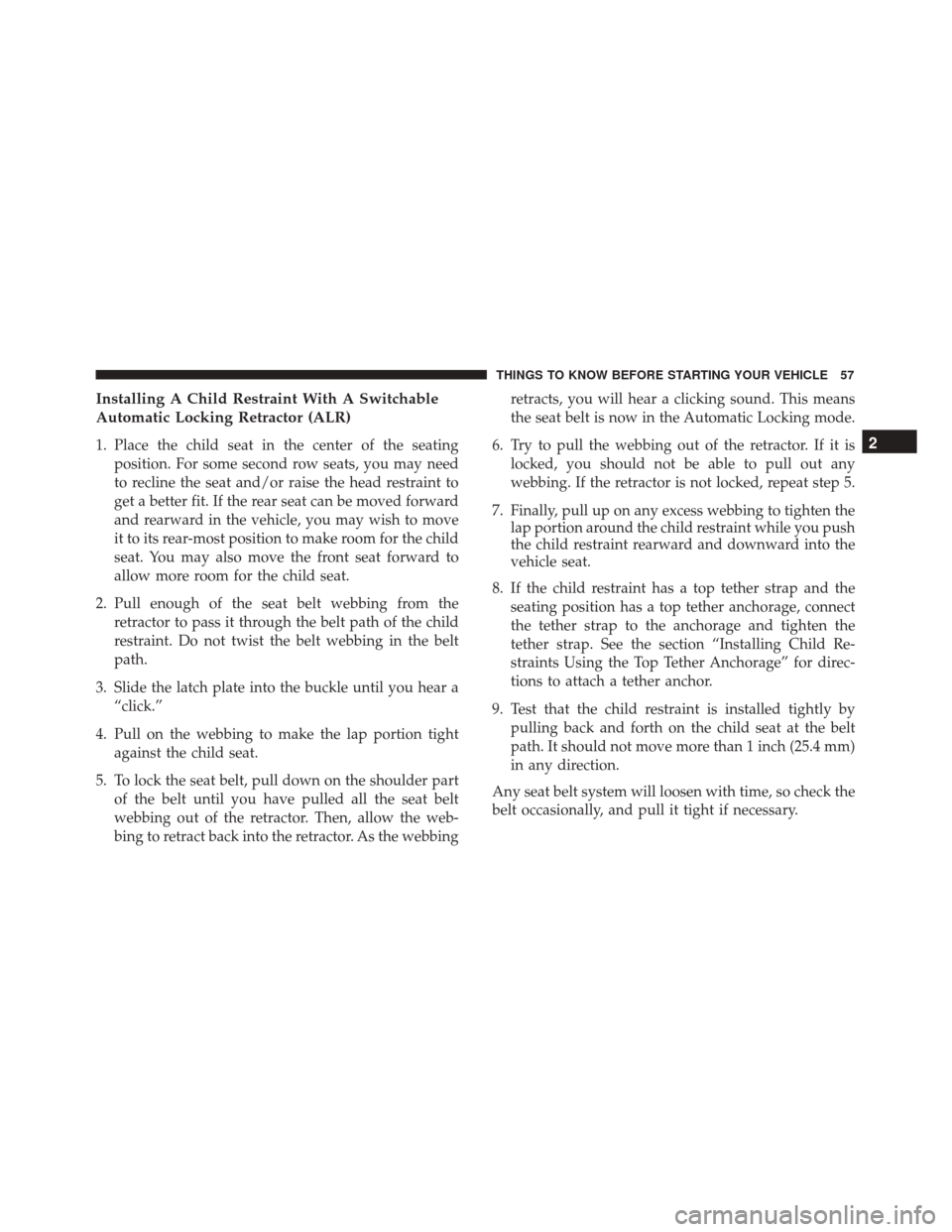
Installing A Child Restraint With A Switchable
Automatic Locking Retractor (ALR)
1. Place the child seat in the center of the seatingposition. For some second row seats, you may need
to recline the seat and/or raise the head restraint to
get a better fit. If the rear seat can be moved forward
and rearward in the vehicle, you may wish to move
it to its rear-most position to make room for the child
seat. You may also move the front seat forward to
allow more room for the child seat.
2. Pull enough of the seat belt webbing from the retractor to pass it through the belt path of the child
restraint. Do not twist the belt webbing in the belt
path.
3. Slide the latch plate into the buckle until you hear a “click.”
4. Pull on the webbing to make the lap portion tight against the child seat.
5. To lock the seat belt, pull down on the shoulder part of the belt until you have pulled all the seat belt
webbing out of the retractor. Then, allow the web-
bing to retract back into the retractor. As the webbing retracts, you will hear a clicking sound. This means
the seat belt is now in the Automatic Locking mode.
6. Try to pull the webbing out of the retractor. If it is locked, you should not be able to pull out any
webbing. If the retractor is not locked, repeat step 5.
7. Finally, pull up on any excess webbing to tighten the lap portion around the child restraint while you push
the child restraint rearward and downward into the
vehicle seat.
8. If the child restraint has a top tether strap and the seating position has a top tether anchorage, connect
the tether strap to the anchorage and tighten the
tether strap. See the section “Installing Child Re-
straints Using the Top Tether Anchorage” for direc-
tions to attach a tether anchor.
9. Test that the child restraint is installed tightly by pulling back and forth on the child seat at the belt
path. It should not move more than 1 inch (25.4 mm)
in any direction.
Any seat belt system will loosen with time, so check the
belt occasionally, and pull it tight if necessary.2
THINGS TO KNOW BEFORE STARTING YOUR VEHICLE 57
Page 60 of 338
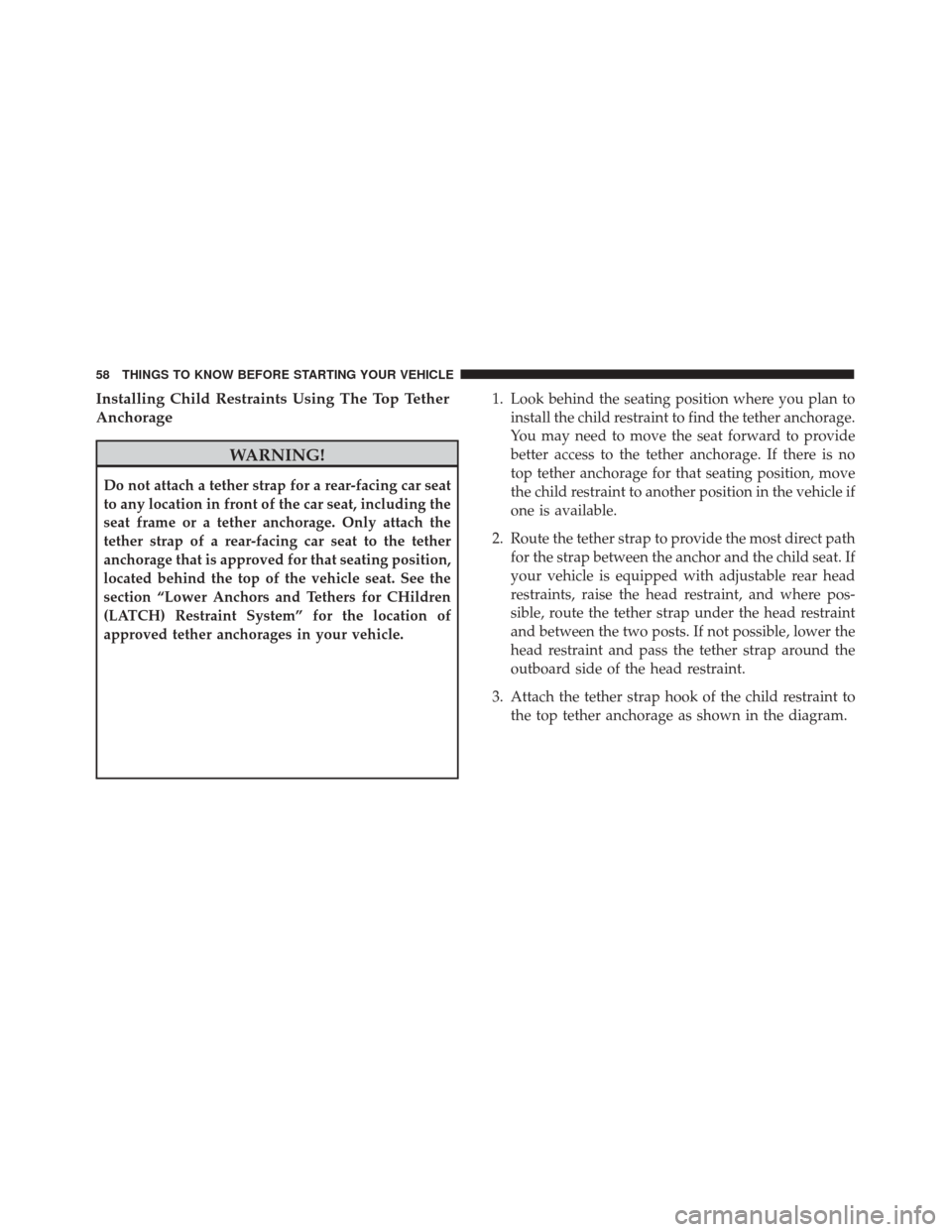
Installing Child Restraints Using The Top Tether
Anchorage
WARNING!
Do not attach a tether strap for a rear-facing car seat
to any location in front of the car seat, including the
seat frame or a tether anchorage. Only attach the
tether strap of a rear-facing car seat to the tether
anchorage that is approved for that seating position,
located behind the top of the vehicle seat. See the
section “Lower Anchors and Tethers for CHildren
(LATCH) Restraint System” for the location of
approved tether anchorages in your vehicle.
1. Look behind the seating position where you plan toinstall the child restraint to find the tether anchorage.
You may need to move the seat forward to provide
better access to the tether anchorage. If there is no
top tether anchorage for that seating position, move
the child restraint to another position in the vehicle if
one is available.
2. Route the tether strap to provide the most direct path for the strap between the anchor and the child seat. If
your vehicle is equipped with adjustable rear head
restraints, raise the head restraint, and where pos-
sible, route the tether strap under the head restraint
and between the two posts. If not possible, lower the
head restraint and pass the tether strap around the
outboard side of the head restraint.
3. Attach the tether strap hook of the child restraint to the top tether anchorage as shown in the diagram.
58 THINGS TO KNOW BEFORE STARTING YOUR VEHICLE